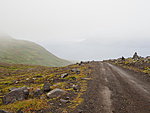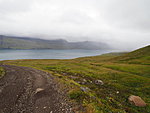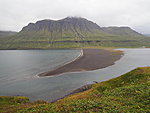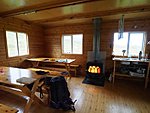Whole night wind howls around the house and tries to
open doors and windows.
In the morning I spend some chapters with Eco. To
the next hut is 14 kilometers along a jeep track and trail description says it
takes five hours. It rains and it is not certain if I can sit cozily inside there
as well. Better not to arrive too early.
When I finally go out at about 12 then rain has
stopped for a moment. Around me are no doubt awesome views hidden in the cloud.
It does not really start to rain but wind blows the cloud over the road back
and forth. The road winds up somewhere and down from the other side. Outlines
of a bay are barely visible. On this side is drier but in the end of the bay
waits cloud like a wall. The bay ends with a lagoon and on the other shore a
cool mountain named Gunnhildur looks at me.
Soon it starts to rain. Exactly as planned. Gravel
road for the rainiest day. So I don’t loose the trail and feet don’t get very
wet. The shoes handle rain surprisingly well. My feet inside feel dry and warm.
Until I have to walk through water. Yak. But feet warm up in a few moments and
with every step there is less water inside. The upper parts of the shoes even
get dry despite the rain.
When I can already see the hut in the distance a car
drives past me, backs and asks if I go there and if I want a ride. Well, why
not. So I ride the last three kilometers in a heated car with two guys who go
to make some repairs at the hut. They promise better weather for tomorrow. The
story ends with lightning a fire in the fireplace and us having lunch and
coffee together. Or actually it is more like they make me lunch and I drink
some of their coffee. The older guy not only knows Siggi but also Rakel with
whom I was skiing in Hornstrandir last winter. He has walked a lot in
Hornstrandir and we enthusiastically draw with our fingers on the map who has
hiked where. He gives me an email address where one can write to volunteer to
be a warden in one of the huts in the summer. The younger guy cannot stop
wondering that I’ve learned the language of such a small nation and tries to
figure out my life’s story. This of course is tricky even in Estonian.
The men set to work. The hut is now so hot that I
have to take off some clothes. From the shelf I find a book where the bays are
called Hornstrandir of the Eastfjords (page 33, Ferðafélag Íslands árbók 2008).
As there here also most of the farms were abandoned in the middle of last
century and nature has destroyed most of them. On the hiking map are names of
each farm with a year when it was abandoned. In the book is a picture of a
local education ... who lived in a place where I just walked by. A sign said:
Seljamýri, ruined in 1942.
A poem from Gyrðir Elíasson „Eyðibýlið“ suits here:
Rökkvað
undir fjallinu
og lasleg hús
biða eftir
fólki
og dýrum
Sem koma
aldrei
aftur
(It gets dark under the mountain and a shabby house
waits for people and animals who never come back)
In addition I find out that Hvítserkur is a special
mountain that people come to look at even without climbing it. Basically it can
be summarized that yesterday I cursed a pile of rocks that dates back some
12-126 million years. The area is the oldest part of Iceland.
The warden arrives with two black dogs and the
workmen leave, washing dishes before they go and wishing me good luck for the
rest of the hike with a warning that tomorrow’s trail is not well marked and it
is easy to get lost. I set some waypoints into GPS. This stretch is the first
one that is not marked on the GPS map.
I keep the fire going, feeding it sparingly one
piece at the time. Wood comes from the area near Hengifoss where I was
surprised to see so many trees. It is the biggest woodland area in Iceland but
trees are imported.
No Icelandic language novels in this hut but I find
a story of „a common man“, someone called Robert Seethaler „Ein ganzes Leben“.





Add a comment